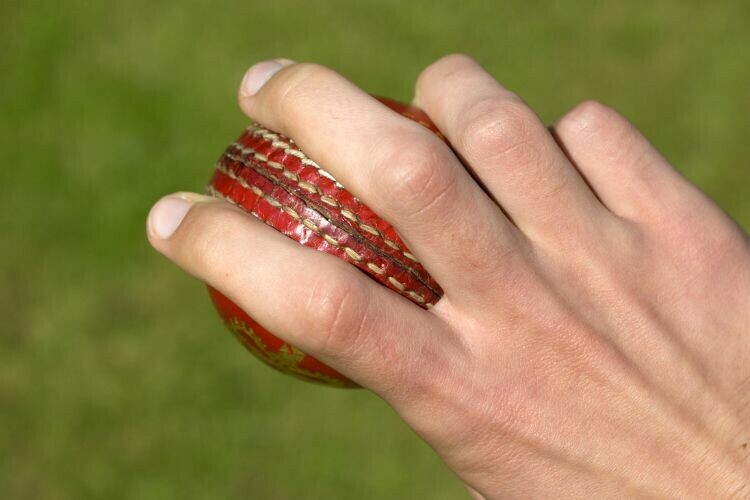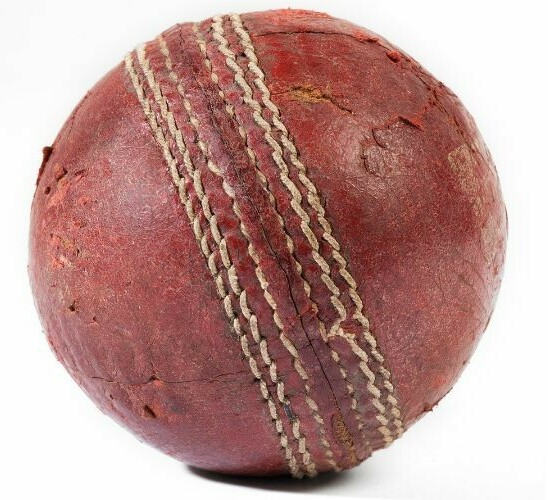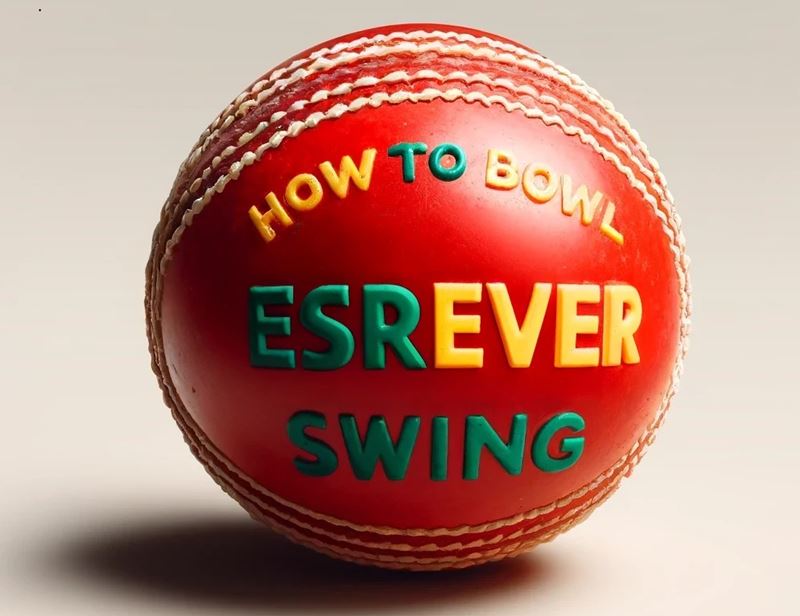We’ve talked in our previous two posts about how to bowl inswing and how to bowl outswing.
In this post, we’ll be taking the swing lesson to the ‘advanced’ level, with reverse swing.
Unlike conventional swing (which we talked about in the previous two posts) where the ball deviates in the air towards the rough side, reverse swing propels the ball in the opposite direction … towards the shiny side.
This paradoxical movement occurs when the ball is considerably older and the shine has been meticulously maintained on one side, with the other side becoming substantially rougher and worn.
We’ll talk more about the science behind reverse swing soon, but the primary distinction between conventional swing and reverse swing lies in the condition and age of the ball.
Conventional swing typically occurs early in the innings with a newer ball, where the air flows smoother over the shiny side, causing the ball to swing towards the rough side.
In contrast, reverse swing comes into play later in the innings, often after the ball has seen extensive use.
As the ball ages, the dynamics of airflow change. The rough side disrupts the air more significantly than the smooth, well-maintained side, causing the ball to swing towards the shiny side unexpectedly.
The early innovators of reverse swing came from the Pakistan side of the late 1970s. Legendary Pakistani bowlers such as Sarfraz Nawaz pioneered this art, which was later perfected by the likes of Imran Khan, Wasim Akram, and Waqar Younis.
These iconic players revealed the potency of reverse swing on the international stage, transforming it into a crucial aspect of fast bowling in cricket. The enigmatic nature of reverse swing, coupled with its dramatic impact on games, has made it a revered and somewhat secretive skill, passed down among the ranks of fast bowlers who delight in its mystique and effectiveness in deceiving batsmen.
It is a very difficult skill to master, as it doesn’t just rely on your skill as a bowler, but also your team’s ability to maintain the ball properly, as well as the pitch’s ability to scuff it up nicely.
The Science Behind Reverse Swing
To understand reverse swing, we’ll remind you also of the science behind conventional swing, and then compare the two. Understanding the science behind reverse swing and conventional swing in cricket offers fascinating insights into how a cricket ball behaves under different conditions. Both phenomena depend on the principles of aerodynamics, but the conditions and outcomes of each vary distinctly.
Conventional Swing
Conventional swing occurs when a cricket ball deviates in the air towards the rough side. This type of swing is usually observed with a relatively new ball that has one shiny, well-maintained side and one rough side.
The key to conventional swing is the difference in air flow around the ball as it speeds towards the batter. Air flows smoother over the shiny side because of its lower surface roughness, which reduces air resistance and allows the air to stick closer to the surface longer.
On the rough side, the airflow is more turbulent due to higher friction and separates from the ball’s surface more quickly.
This difference in the separation points of airflow creates a pressure gradient across the ball. The side with the later separation point (shiny side) experiences higher pressure compared to the rough side.
As a result, the ball swings towards the rough side due to this uneven distribution of pressure.
Reverse Swing
Reverse swing, on the other hand, behaves in the opposite manner. It occurs when the ball is older, and both sides have undergone different levels of wear, but crucially, the ball must be at a much higher speed, typically above 135 to 145 km/hr (85-90 mph).
In reverse swing, despite the rough side having more surface friction, the ball swings towards the shiny side.
The physics of reverse swing also revolves around the differential air pressure created by the airflow around the ball, but with a crucial difference due to the speed of the ball and the degree of wear.
At high speeds, the turbulent layer of air on the rough side can stick to the ball longer than it does at lower speeds, delaying the point of airflow separation beyond that of the smoother side.
Thus, the smooth side, despite being slick, sees air separating earlier, creating lower pressure compared to the rough side. Consequently, the ball swings towards the shiny, smoother side.
Comparing Both Swings
The critical differences between conventional and reverse swing lie in the conditions of the ball’s surface, the speed at which the ball is bowled, and how the seam is positioned and manipulated by the bowler.
In conventional swing, the seam is used to stabilize the ball as it moves through the air, enhancing the effect of the air flowing over the rough and smooth sides.
In reverse swing, bowlers often angle the seam towards the shiny side to help direct the ball towards it, using the seam almost like a rudder.
Both types of swing require meticulous maintenance of the ball’s condition by the bowling team.
However, the skills and strategies involved in deploying them effectively vary, with reverse swing generally considered harder to master due to the higher speeds and precise control required over the older ball’s behaviour.
Mastering the Grip
Typically, the grip for reverse swing doesn’t deviate drastically from the tradition seam equivalent. This usually means that, for outswing, the seam is pointed towards first slip, with the fingers either along the seam, or at a slight angle to the seam on the off-side of the ball.

Similarly, for inswing, the seam is pointed towards leg-slip, with the fingers usually slightly angled to the seam, on the on-side of the ball.
The difference between traditional and reverse swing is which side is the shiny side. For traditional swing, the swing is in the direction of the rough side. So, for outswing, you would point the seam at first slip, and the rough side of the ball would be on the off side, away from the batsman.
For inswing, you would point the seam at leg-slip, and the rough side of the ball would be on the on-side, towards the batsman.
As you can guess, with reverse swing, it is reverse. For outswing, you would still point the seam at first slip, but this time it would be the shiny side that would be on the off-side, away from the batsman. And for inswing, you would still point the seam at leg-slip, but the shiny-side would now be on the on-side, away from the batsman.
Crafting the Perfect Reverse Swing Delivery
Pace plays a pivotal role in reverse swing. Unlike conventional swing, which can be effective at moderate speeds, reverse swing typically requires higher speeds to be truly effective.
Speed intensifies the aerodynamic forces acting on the ball, amplifying the effect of the altered airflow caused by the rough and smooth sides of the ball. This increase in pace should be matched with precise control to ensure the ball swings late, making it harder for the batsman to read and react.
The delivery angle is another critical factor in maximizing reverse swing. Altering the angle at which the ball is delivered can change the point at which it begins to swing and the trajectory it follows.
For example, try delivering the ball from wider of the crease for a ball or two; this can create a more pronounced angle into or away from the batsman, enhancing the deception.
Experimenting with different release points—over the wicket or around the wicket—can also alter the ball’s path significantly.
Training: Building a Reverse Swing Bowler’s Arsenal
To become proficient in reverse swing requires targeted training and a dedicated regimen. Specific exercises and drills can help you develop the necessary skills and physical attributes to master this demanding aspect of cricket.

Planks
Strength and flexibility are paramount. Exercises that enhance core stability, shoulder strength, and wrist flexibility are particularly beneficial. Try some core exercises like planks and Russian twists to help maintain a stable torso during the delivery; this is crucial for controlling the ball’s trajectory.
Shoulder strengthening exercises such as overhead presses and lateral raises build the endurance needed to maintain pace throughout long spells.
Additionally, wrist and forearm exercises, including wrist curls and extensions, are essential for achieving the snap required at the release point of the ball, crucial for manipulating the seam and angle.
Speed drills form another critical component of your training for reverse swing. Incorporate sprint intervals into your training sessions; this can improve your run-up speed and explosive power.
Drills that simulate your bowling action, such as medicine ball throws and plyometric push-ups, can also enhance the fast-twitch muscle fibres used during the delivery phase.
A reverse-swing yorker is an extremely difficult ball for a batter to face, but it takes a lot of practice to get it right. Setting up targets on a good length and practicing hitting them consistently can refine your aim and control. This drill not only helps in landing the perfect yorker but also enhances overall accuracy for all types of deliveries.
You can gain consistency through repetitive practice. Focus on maintaining a consistent run-up and action during practice sessions.
Use video analysis to monitor and adjust your technique. Regular net sessions with specific goals for swing and seam position help in developing muscle memory and refining your skill set.
Strategic and Psychological Ploys in Reverse Swing
Reverse swing is not only a technical skill but also a potent psychological weapon in cricket. Understanding when and how to deploy it can unsettle batsmen and shift the momentum of a game.
Reverse swing has become like the holy grail for fast bowlers. It is such a difficult thing to master, and even if you have the speed and the capability to do it, the conditions need to be in your favour.

The ball needs to be properly (and legally) roughed up on one side, and still smooth on the other. This requires the bowling side to be rigorous in their attention of caring for the ball, but it also requires the pitch to be abrasive enough to cause the roughing up in the first place.
The reason that reverse swing can be so psychologically damaging to the batter, is because of all the things that have to work in the bowler’s favour to get it to happen. The batter may then think that the favour of the ‘cricketing gods’ are favouring the bowling team.
Even if that doesn’t happen, a ball that is reverse swinging plays on a batter’s mind, because they don’t know when or how much (or even if) a ball is going to swing.
Often, the reverse swing happens late in the path of the delivery; a ball that could appear to be full outside off, suddenly ends up veering towards the batter’s feet. Even if the batter keeps it out, they are thinking about the next ball, and the ball after that, wondering when (or if) it will swing.
And not only the batter themselves, but the batters back in the pavilion watching this unfold. They are now more concerned about the reverse swinging ball that it mentally changes how they intend to bat.
Reverse swing is difficult, even if you are proficient at it. You must possess the resilience to continue their strategy even when initial attempts do not succeed, along with the acuity to make in-game adjustments based on the batsman’s behaviour and prevailing conditions.
Observing how batsmen handle different deliveries can provide you insights that lead to refined tactics, such as altering the seam angle or adjusting the length and pace of the deliveries.
Solutions to Common Reverse Swing Conundrums
Mastering reverse swing in cricket involves not just learning the right techniques but also overcoming frequent pitfalls that can hinder its effectiveness. Identifying and remedying these common mistakes is crucial for any bowler aspiring to excel in this specialized area.
One common mistake is improper ball maintenance. For reverse swing to be effective, the ball must have a distinct difference between the rough and smooth sides. Failing to properly maintain this distinction can lead to ineffective deliveries.
Regularly polishing the smooth side and allowing the rough side to deteriorate naturally—or under controlled conditions—is essential. As a bowler, you should continuously inspect the ball and coordinate with teammates to ensure it is kept in optimal condition for reverse swing.
Another typical challenge is incorrect grip and release. The grip should not be too tight as it can restrict the wrist’s natural flick at the delivery point, which is crucial for imparting the correct angle and seam position. Practice with a relaxed grip and focus on the wrist’s position during release to refine your reverse swing.
Adapting to adverse conditions and maintaining composure under pressure are also vital. Whether it’s windy conditions, a particularly flat pitch, or a high-pressure game situation, you must stay focused and adapt your bowling strategies accordingly. This might mean adjusting the length of the delivery, varying your pace, or changing the angle of attack to keep batsmen guessing.
Last Word on Reverse Swing
We’ve said it before, and we’ll say it again. Reverse swing is hard. Hey, even swing bowling is hard. You don’t have control of all the factors that can help or hinder reverse swing, so even if you know how to reverse swing and have done it before, there will be many days when reverse swing will just not work for you.
A bowler should never rely on just one weapon. You don’t need a tonne of variations, but a couple will help you. Begin with line and length, maybe add the ability to seam it off the pitch, or swing it in the air.
Maybe then work at trying to bring in reverse swing, but don’t be discouraged if it doesn’t work.
In an upcoming post, we’ll talk about another piece of variation you can add to your bowling weapon wheel … the slower ball, and the different varieties of slower balls in existence.
Do you have a favourite reverse swing bowler? Do you remember watching the maestros like Wasim Akram reverse swinging it like a magician? Are there any current bowlers that you enjoy watching reverse swing the ball? Leave your comments in the comment box, and let’s get a conversation started.

